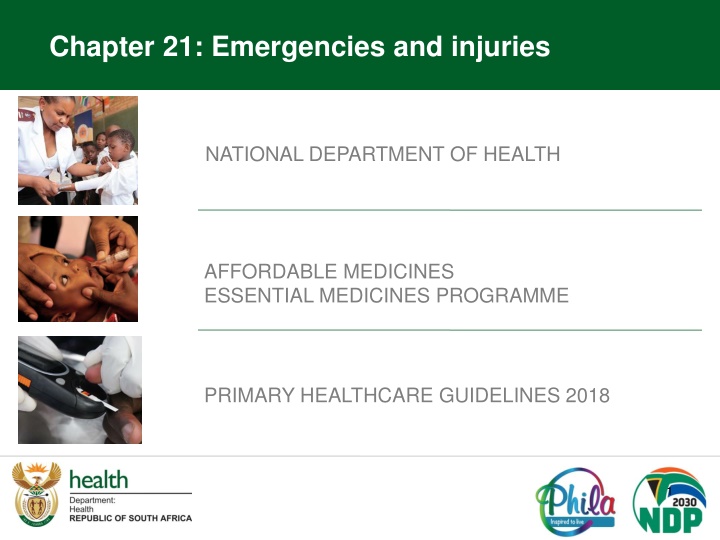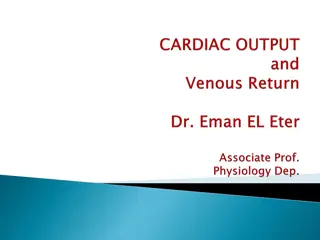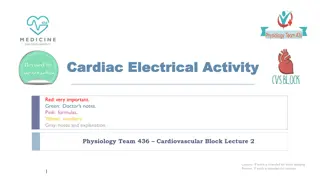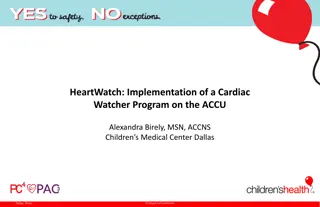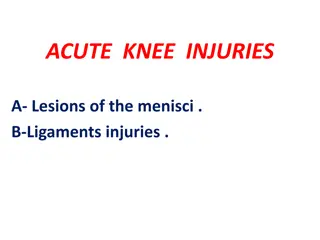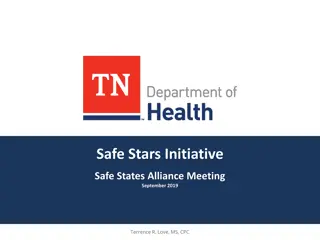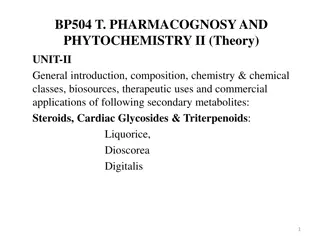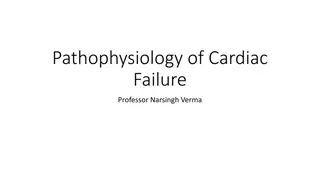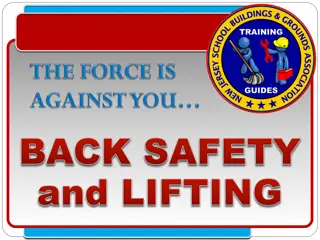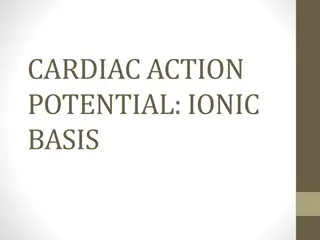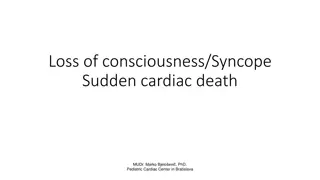Management of Cardiac Emergencies and Injuries: Guidelines and Updates
This document provides detailed information on managing cardiac emergencies and injuries, including bradycardia, tachydysrhythmias, and cardiac arrest in adults and children. It outlines specific interventions such as atropine, adrenaline, and synchronized cardioversion, with changes in protocols and rationale for each condition. The content emphasizes the importance of following recognized algorithms and guidelines for optimal patient outcomes.
Download Presentation

Please find below an Image/Link to download the presentation.
The content on the website is provided AS IS for your information and personal use only. It may not be sold, licensed, or shared on other websites without obtaining consent from the author.If you encounter any issues during the download, it is possible that the publisher has removed the file from their server.
You are allowed to download the files provided on this website for personal or commercial use, subject to the condition that they are used lawfully. All files are the property of their respective owners.
The content on the website is provided AS IS for your information and personal use only. It may not be sold, licensed, or shared on other websites without obtaining consent from the author.
E N D
Presentation Transcript
Chapter 21: Emergencies and injuries NATIONAL DEPARTMENT OF HEALTH AFFORDABLE MEDICINES ESSENTIAL MEDICINES PROGRAMME PRIMARY HEALTHCARE GUIDELINES 2018 1
EVIDENCE Please access the National Essential Medicines List Committee (NEMLC) report for detailed evidence (including rationale, references and costings) informing decision-making on medicine addition, amendments and deletions: http://www.health.gov.za/index.php/standard-treatment-guidelines-and- essential-medicines-list/category/285-phc DISCLAIMER This slide set is an implementation tool and should be used alongside the most recently published STG available on the EML Clinical Guide Application. This information does not supersede or replace the STG itself. 2
Changes in layout Chapter layout amended to delineate 3 major sections: A.Cardiopulmonary resuscitation B.Medical emergencies C.Trauma General: Resuscitation algorithms were inserted, with permission from the Resuscitation Council of South Africa (RCSA) for adaptation, where applicable. 3
Bradycardia DESCRIPTION A pulse rate <50 beats/minute in adults A pulse rate <60 beats/minute, in children despite effective oxygenation and ventilation. CHANGES New section Adults: if unstable, atropine, IV, ADDED Children: - If unstable, adrenaline, IV, ADDED - If heart block or increased vagal tone suspected: atropine, IV, ADDED REASON Separate management of bradycardia developed, as management was removed from updated 2015 Basic Life Support for healthcare workers algorithm STG for the RCSA 4
Tachydysrhythmias DESCRIPTION In adults, tachydysrhythmias refer to a pulse rate >150 beats/minute. In children, tachycardia refers to a pulse rate of more than normal range for age (see table). CHANGES New section Guidance on synchronised cardioversion provided for unstable patients Cross referral to Hospital Level STGs for medicine treatment REASON New section, not previously covered and added for continuum of care 5
Cardiac arrest, adults DESCRIPTION Described as the loss of a heart beat and a palpable pulse, irrespective of the electrical activity captured on ECG tracing CHANGES Adrenaline (epinephrine), AMENDED, intraosseous route ADDED Atropine, IV, DELETED REASON Aligned Resuscitation Council algorithm, "Basic life support for healthcare providers . No evidence for benefit of atropine in asystole or bradycardic electrical activity cardiac arrest. with the South African pulseless 6
Hypoglycaemia and hypoglycaemic coma DESCRIPTION Hypoglycaemia is a blood sugar < 3 mmol/L (< 2.6 mmol/L in neonate) and may rapidly cause irreversible brain damage and/or death. CHANGES Adults: dextrose 50%, IV, AMENDED to dextrose 10% Note: The volume of dextrose has been increased, to compensate for the lower concentration. Children: dextrose IV commenced immediately after the first dextrose bolus. REASON Adults: Dextrose 10% results in better post- treatment blood glucose concentrations than dextrose 50% Children: Reduce the risk of hypoglycaemia relapse. 7
Pulmonary oedema DESCRIPTION A life-threatening condition with abnormal accumulation of fluid in the lungs. CHANGES Isosorbide dinitrate, oral, dosing AMENDED Morphine, IV, directions for use AMENDED Morphine only given if patient very anxious or restless. REASON Nitrate dosing amended from "4 hourly" to "every 5-10 minutes . Morphine directions for administration clarified. 8
Anaphylaxis DESCRIPTION A very severe allergic reaction that usually occurs within seconds or minutes after exposure to an allergen (up to 1 hour). CHANGES First priority treatment to give immediately: Adrenaline (epinephrine), IM, dose AMENDED Second priority: Oxygen, ADDED If hypotensive: sodium chloride 0.9%, IV, ADDED If wheeze: salbutamol and ipratropium, nebulisation, ADDED Hydrocortisone, IM/IV, dose AMENDED REASON Adrenaline: dose corrected for anaphylaxis. Aligned with RSCA Guidelines Hydrocortisone: doses aligned with the Adult Hospital Level (2015) and Paediatric Hospital Level (2017) STGs and EML. 9
Seizures and status epilepticus (children) DESCRIPTION A seizure is a change in movement, attention or level of awareness that is sustained or repetitive, and occurs because of abnormal and excessive neuronal discharge within the brain. Status epilepticus is a series of seizures. CHANGES Initial benzodiazepine treatment Midazolam, buccal, AMENDED - 2nd dose of buccal midazolam added, if seizure control not achieved after first dose. Midazolam, IM, ADDED REASON Aligned with Guidelines and expert opinion. Midazolam, IM is as effective as diazepam, IV and more practical to administer. Accessing phenobarbitone injections through section 21 not considered feasible at primary level of care. Second line treatment Phenobarbitone, oral via NGT, RETAINED Phenobarbitone, IV, NOT ADDED 10
Seizures and status epilepticus (adults) DESCRIPTION A seizure is a change in movement, attention or level of awareness that is sustained or repetitive, and occurs because of abnormal and excessive neuronal discharge within the brain. Status epilepticus is a series of seizures. CHANGES Midazolam, buccal, ADDED - with recommendation for a 2nd dose as needed. Midazolam, IM, directions for use AMENDED Diazepam, IV, directions for use AMENDED -Maximum dose amended Benzodiazepine caution box updated REASON Midazolam, buccal/IM :Aligned with Adult Hospital Level STGs and NICE Guidelines. Diazepam, IV: Aligned with SAMF, 2016. 11
Human bites DESCRIPTION Human bites may be accidental or intentional (form of assault). CHANGES Section separated out from animal bites for clarity Tetanus toxoid vaccine, IM, ADDED Hepatitis B vaccine, ADDED Hepatitis B immune globulin, accessible through referral process. HIV PEP, NOT ADDED REASON Separate STGs for animal & human bites as it was reported that nurse prescribers were probably administering rabies vaccines to human bite victims. 12
Exposure to poisonous substances DESCRIPTION Poisoning may occur by ingestion, inhalation or absorption of substances through skin or mucus membranes. CHANGES Organophosphate and carbamate poisoning: Children: Atropine, IV, directions for use AMENDED Opioid overdose Children: Naloxone, IV, directions for use ADDED REASON Aligned with Paediatric Hospital STGs and EML, 2017; BUT dosing limited to bolus doses for primary level of care. Naloxone in children added as a new recommendation. 13
Post exposure prophylaxis (Rape and sexual assault) + (Inadvertent/ non-occupational) DESCRIPTION Exposure to infectious fluids through rape or sexual assault Inadvertent exposure to infectious fluids may be: - Sharing of needles during recreational drug use - Consensual sexual exposure, burst condoms - Human bites - Contact sports with blood exposure CHANGES Hepatitis B vaccine, ADDED with a cross referral to occupational exposure section Hepatitis B immunoglobulin,accessible through referral process. REASON Aligned with Guidelines 14
